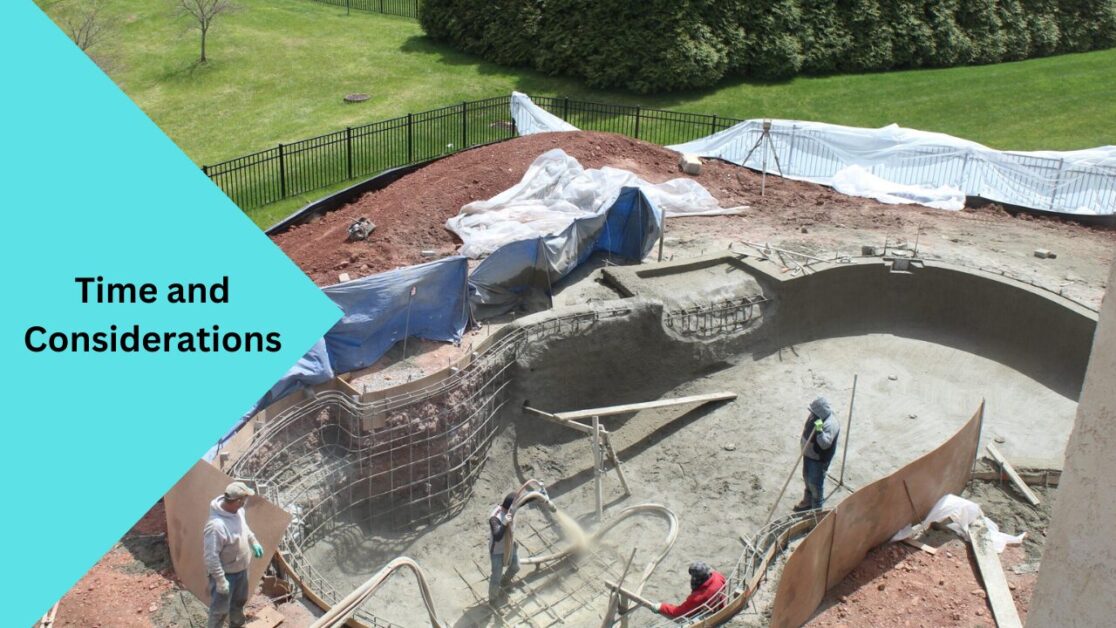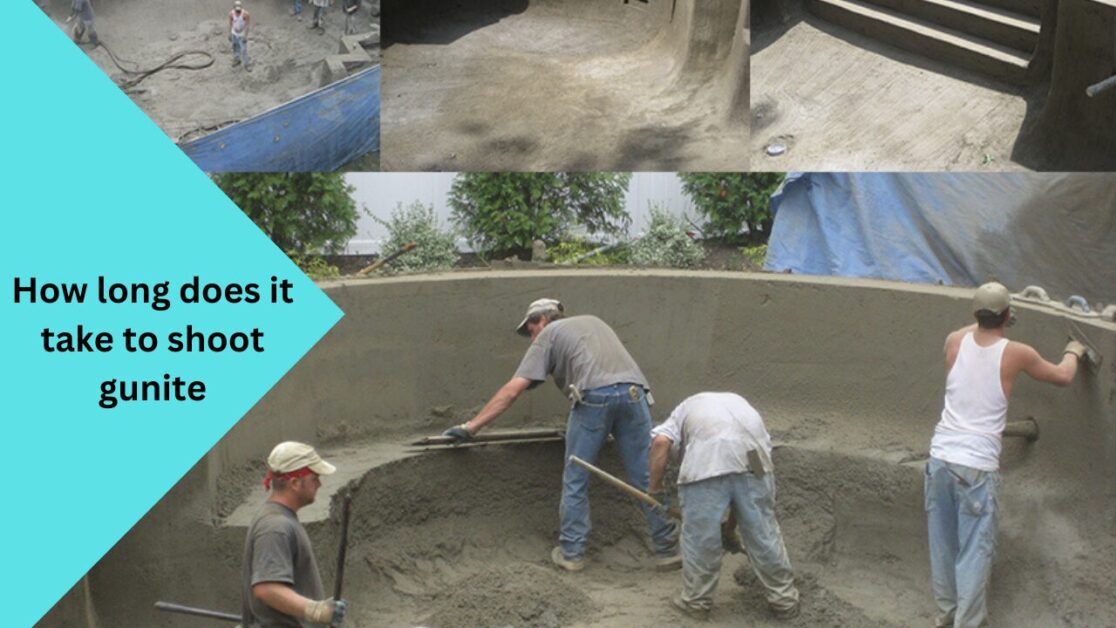Are you considering a construction or renovation project that involves gunite? One important aspect to consider is the time it takes to shoot gunite, as it can directly impact your project timeline and budget. Understanding the duration for shooting gunite and the subsequent curing process is crucial for efficient planning and execution. In this comprehensive guide, we will explore”how long does it take to shoot gunite”to provide you with a complete understanding of this topic. Let’s dive in!
What is Gunite, and How is It Used?
Before we delve into the duration for shooting gunite, let’s first understand what gunite is and how it is commonly used. Gunite is a mixture of cement, sand, and water, which is pneumatically sprayed onto surfaces using a high-pressure hose. It offers exceptional durability, flexibility, and can be applied to a variety of construction and repair projects. Gunite is commonly used for building or repairing swimming pools, tunnels, retaining walls, and even sculptural and artistic applications. For Detail about Depth Details about Gunite just check out our latest article about Exploring Gunite Pools: Pros and Cons
The Process of Shooting Gunite
To better grasp the duration for shooting gunite, it’s essential to have a clear understanding of the shooting process itself. Shooting gunite involves several steps, including:
- Preparation: The surface must be properly prepared before gunite is applied. This involves ensuring the area is clean, free of debris, and any necessary forms or molds are in place.
- Mixing the Gunite Mixture: The gunite mixture is prepared by combining cement, sand, and water in the correct ratios. Precise measurement and thorough mixing are vital to achieve a high-quality gunite mix.
- Loading the Gunite Hopper: The gunite mixture is loaded into a specialized machine known as a gunite hopper, which is equipped with a rotor and high-pressure hose.
- Shooting the Gunite: With the gunite hopper in place, the gunite mixture is pneumatically delivered through the hose, controlled by a skilled operator. The mixture is sprayed onto the desired surface, creating a thick and durable layer.
- Finishing: After the gunite is applied, skilled workers use various tools to shape, smooth, and finish the surface as desired.
Now that we have a clear understanding of the shooting process, let’s explore the duration it takes to shoot gunite.
How Long Does It Take to Shoot Gunite?
The duration for shooting gunite can vary depending on several factors, including the size of the project, the complexity of the design, the experience of the crew, and the equipment being used. On average, it can take anywhere from a few hours to several days to shoot gunite. Let’s delve into these factors to gain a better understanding.
Size of the Project
The size of the project plays a significant role in determining the time required to shoot gunite. Larger projects, such as constructing a new pool or building a tunnel, will naturally take longer to complete compared to smaller repairs or surface applications.
Complexity of the Design
The complexity of the design can also impact the shooting duration. Intricate shapes, curves, or detailed patterns may require more time and precision during the shooting process. Additionally, if multiple layers of gunite are needed, extra time will be necessary to allow each layer to cure before proceeding.
Experience of the Crew
The experience and expertise of the crew executing the gunite shooting are crucial in maintaining efficiency and accuracy. Experienced crews with a deep understanding of the shooting process will typically work more swiftly and produce a higher quality finish.
Equipment Being Used
The equipment utilized for shooting gunite can also influence the duration. Advanced machinery with larger hoppers and higher pressure capabilities can expedite the process, reducing the overall time required for shooting gunite.
The Curing Time for Gunite
Once gunite is sprayed onto the desired surface, it undergoes a curing process to harden and strengthen. The curing time for gunite is an essential factor to consider in your project timeline. It determines when you can proceed with subsequent construction or finishing tasks.
Factors Affecting Gunite Cure Time
Multiple factors can impact the gunite curing time. While the exact duration may vary, it is important to keep the following factors in mind:
- Ambient Temperature: Warmer temperatures generally promote faster curing, while colder temperatures can slow down the process. The ideal temperature range for gunite curing is typically between 50°F (10°C) and 90°F (32°C).
- Humidity Levels: High humidity can extend the curing time, as it slows down the evaporation of water from the gunite mixture.
- Thickness of Gunite Application: Thicker layers of gunite will require more time to cure fully.
It is crucial to consult with your contractor or gunite specialist to determine the estimated curing time based on these factors and the specific conditions of your project.
Shooting Gunite: Best Practices and Tips
Here are some best practices and tips to consider when shooting gunite:
- Hire Experienced Professionals: Ensure that the crew responsible for shooting the gunite has ample experience in handling the material and operating the necessary equipment. This will help guarantee a smooth and efficient shooting process, reducing the overall duration.
- Proper Surface Preparation: Prior to shooting the gunite, make sure the surface is adequately prepared. It should be clean, free from any contaminants, and moistened to promote a stronger bond with the gunite mixture.
- Maintain Consistent Thickness: To prevent inconsistencies and potential issues with curing, make sure the gunite is applied evenly with a consistent thickness across the entire surface.
- Follow Recommended Curing Practices: Adhere to the recommended curing practices provided by your contractor or gunite specialist. Proper curing will ensure the longevity and strength of the gunite.
- Regular Inspections: Conduct regular inspections during the shooting process to address any potential issues or deviations from the desired outcome. This can help prevent delays and ensure a high-quality finish.
Resurfacing a Gunite Pool: Time and Considerations

If you are resurfacing a gunite pool, the time it takes will depend on several factors, including the current condition of the pool, the extent of repairs needed, and the availability of resources. On average, resurfacing a gunite pool can take anywhere from a few days to a couple of weeks. It is best to consult with a professional to assess the specific requirements and provide an accurate timeline.
Ideal Temperature Conditions for Gunite Curing
The temperature conditions during gunite curing are critical for achieving optimal results. The ideal temperature for gunite curing falls between 50°F (10°C) and 90°F (32°C). Temperatures outside this range can potentially affect the strength and integrity of the cured gunite.
Conclusion
By now, you should have a comprehensive understanding of the duration for shooting gunite and the subsequent curing process. The time it takes to shoot gunite can vary depending on factors such as the project size, complexity, crew experience, and equipment used.
Additionally, proper curing is essential to achieve a durable and long-lasting finish. Always consult with professionals and adhere to recommended practices to ensure the success of your gunite project. With careful planning and execution, you can achieve outstanding results and enjoy the benefits of gunite for years to come.

Greetings, fellow pool enthusiasts! I’m Turner Davis, your dedicated guide to the world of pool care and maintenance. With over a decade of experience in the field, I’ve made it my mission to transform ordinary pools into extraordinary aquatic retreats.

